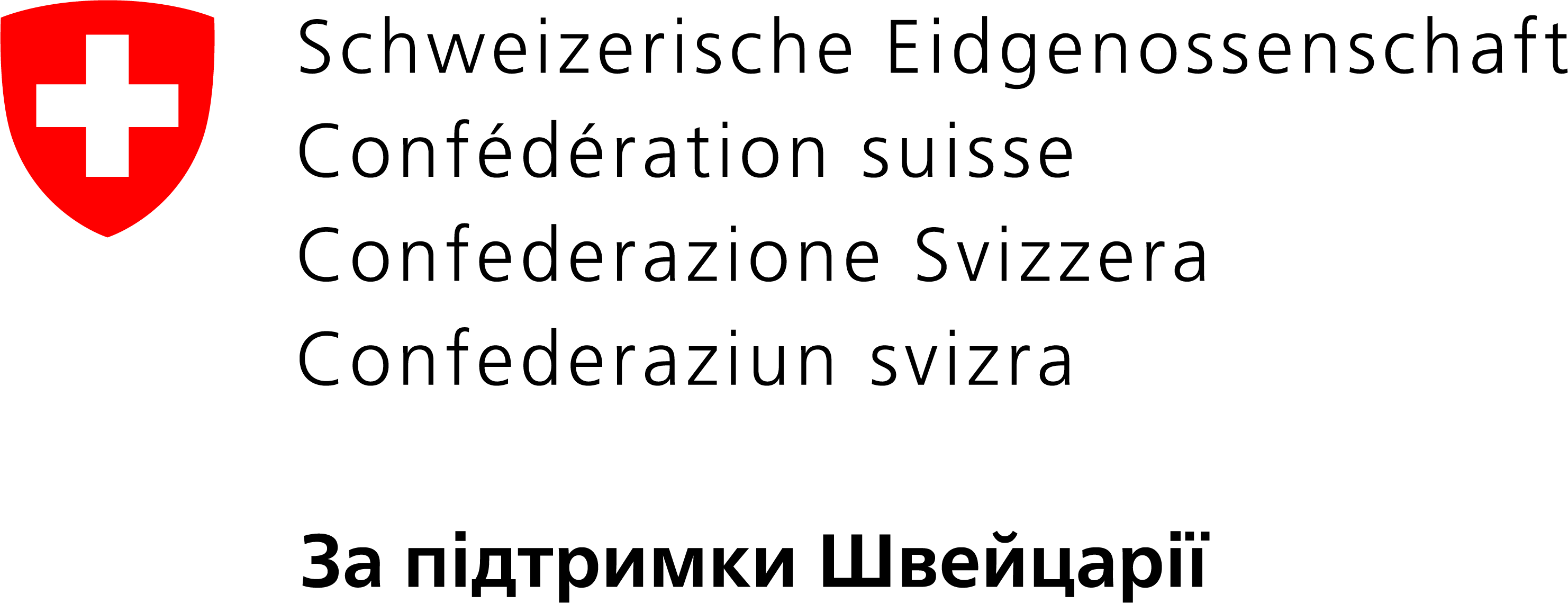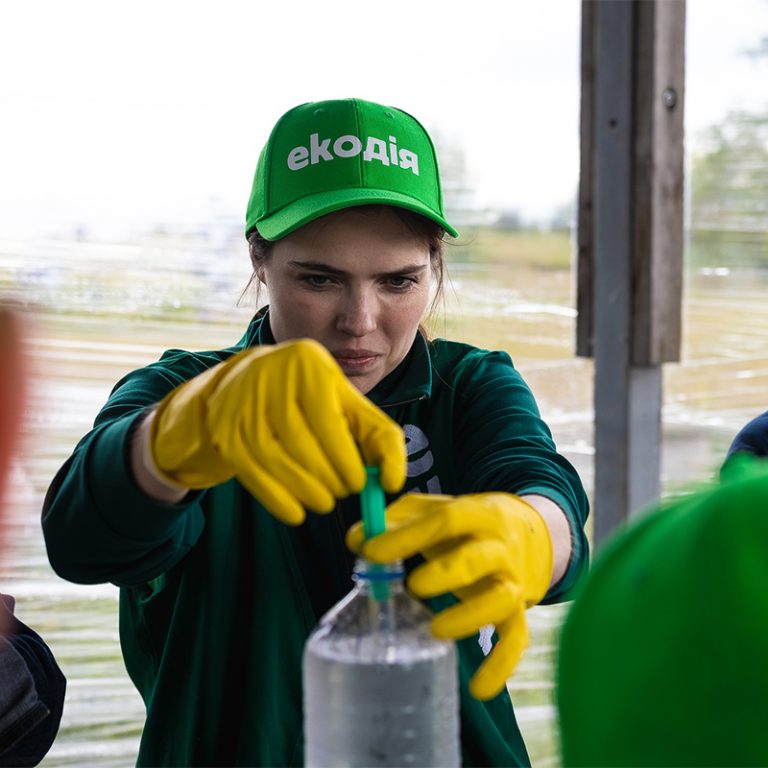More than 70% of the rural population of Ukraine consumes water from wells and boreholes, which often do not meet state standards. This water may contain substances that are dangerous to health and the environment, but is not checked systematically by either household owners or the state water quality control system. The expedition “In search of clean water”, initiated and conducted by the organization “Ecoaction”, aims to find out what kind of water people actually drink in the regions and how to deal with its pollution.
The issue of drinking water quality in Ukraine is acute, especially in rural areas. While cities have access to a centralized water supply, as well as drinking water from pump rooms and a wide selection of bottled water in stores, this is the exception for villages. Monitoring of water quality in rural areas does not work, and drinking water does not meet sanitary standards.
Surface water, which is the main source of water supply in villages, often has an increased content of nitrates, nitrites, phosphates, and ammonium. This is caused, in particular, by the fact that fertilizers and pesticides from agricultural fields seep into rural reservoirs. Most households use either wells that have not been tested for years, or dig boreholes that are not 100% safe, because the underground water may have a high concentration of iron or other dangerous substances.

In 2018, an interactive online map of river pollution in Ukraine was created based on data from the Clean Water State Water Resources Agency. Due to this resource, it is possible to assess the level of contamination of river basins, as well as to find out which factories most clog up rivers in each region.
To make public the problem of water pollution in rural areas, the Ecoaction Center for environmental initiatives collects data from different regions of Ukraine and publishes the results of laboratory tests.
Ecoaction
Ecoaction is a Kyiv-based public organization that unites experts and activists with a common vision of how Ukraine should develop ecologically. A team of like-minded people strive to solve systemic issues by influencing decision-making, changing approaches to production, land-use practices, legislation, and so on. The organization has many areas of environmental activity in such areas as power generation, energy efficiency, transport, air purification, and more. Each participant can work exactly on the topic that resonates the most. So, activist Anna Danyliak, an chose the field of greening agriculture:
“Ukraine is a large agrarian state, and we have had quite serious transformations and developments across this industry over several decades. At the same time, such agricultural booms are not accompanied by the greening of this sector. Rural areas are the basis for agricultural production, and I see that agricultural production affects the quality of life of the local population, because economic growth and economic benefits have a downside. And water is actually one of them.”
The negative impact of agricultural activities on the environment is more difficult to measure compared to the impact of pollution from factories, says Anna. For example, if this is a factory, then a sensor can be installed on the pipe through which waste is discharged and specific emission data can be obtained. That is, the level of spot contamination can be measured. But in agriculture, we are talking about huge territories, fields where agrochemicals and pesticides are introduced. And there is a high risk that some of these chemicals will be washed out or simply seep into the soil and fall into the groundwater.
“This is planar pollution. Imagine what a field looks like, and this whole area can be a source of scattered pollution. And we advocate that it is necessary to take this into account.”
Oksana Omelchuk, the coordinator of volunteers at Ecoaction Community Organization, notes that all processes in the organization are aimed at systemic changes. Thus, the result is long lasting:
“We are trying to change management approaches in our country. And this is somewhat more difficult than the local project “plant a tree”, because you plant a tree and immediately see the result while our work takes more time.”

Since water is one of the most important ecosystem components, changes in the nature of precipitation, temperature conditions, etc. increase water stress (the negative reaction of plants to lack of moisture. — ed.). This affects the availability of traditional water sources (for example, groundwater). Anna explains that there is an interdependence between the amount of water and its quality: the smaller the volume, the greater the risk of increasing the concentration of pollutants.
“For example, you drink tea and add two spoonfuls of sugar. And then suddenly, the climate changes, and you no longer have a full cup, you have half, but you still have the same two spoonfuls of sugar. That is, this concentration — the content of certain chemicals — already exceeds its norm and becomes a problem.”
The state’s water quality monitoring system works best when it comes to large water bodies and rivers that flow through cities where there is a central water intake. But in rural communities, it doesn’t work so well. In May 2021, Ecoaction Community Organization went on an expedition to analyze water from local wells, boreholes, and ponds, check the water safety in communities in 10 regions of Ukraine, and based on the results, develop measures to reduce pollution.
“In rural areas, sources are decentralized. That is, the probability that someone checked them is quite low. And this was confirmed during our expedition when we communicated with the owners of wells or boreholes. If a person themselves (or a relative, or a friend) does not take water samples to the city laboratory, then they can go through life without knowing what they drink.”
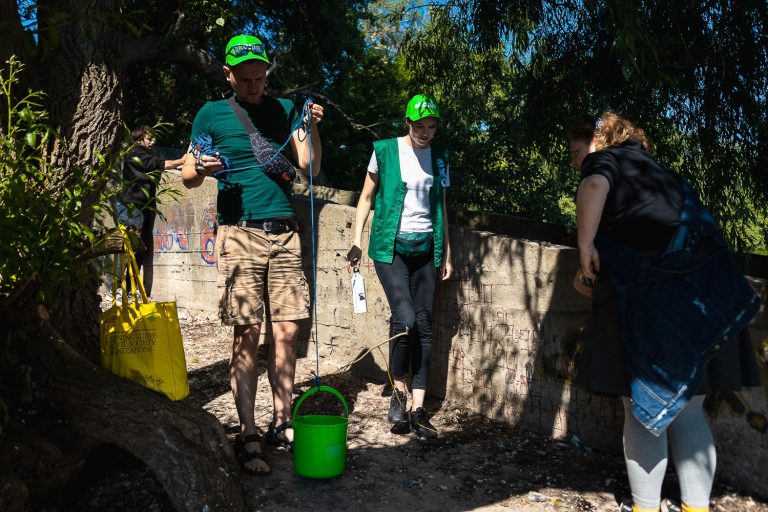
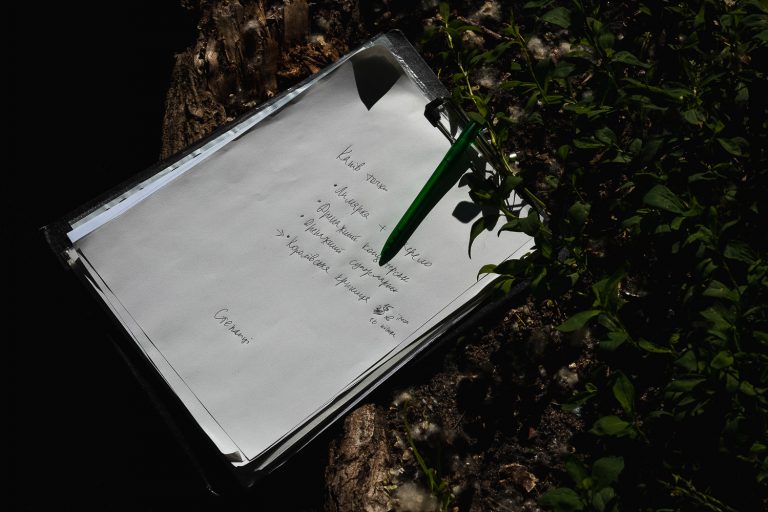
slideshow
Expeditions are coordinated by Anna Danyliak. The team also includes Mykhailo Amosov, the head of the industrial Greening Department, while Artur Sarkisian, Oleksandra Neklesa, and Yana Lazarevska are volunteers. Each of them has their own reasons for joining the organization, but they all share a desire for changes in the field of ecology.
The impetus for the project was the experience of colleagues who created material on the shortage of water resources in Ukraine, as well as one of the international projects, “Transboundary water inspectors: towards common monitoring and use of water resources of the Prypiat River basin”, in which children from environmental clubs learned to explore the waters of the Prypiat basin. Most of all, Anna was impressed by the final stage of the project, during which a new source of drinking water was discovered:
“The happy part. We were about to cut the red ribbon, and someone checked the water from that spring, and the level of nitrates were excellent. It was such a shock, as if a healing spring had opened, and there was simply an incredible amount of nitrates.”
Nitrates, nitrites, phosphates, and other nitrogenous compounds are common in rural areas because the household creates many sources of pollution: fertilizers, animal waste, leaky cesspools, and so on. At the same time, local water inspections are quite rare. Oksana comments on this as follows:
“The presence of certain substances can significantly affect the development of the ecosystem. And so, it is very important that it is constant and no other substances contaminate the water. After all, everything depends on water: people, animals, plants.”
For example, biogenic contamination with nitrates and phosphates is the blooming of water that we see in summer:
“This is due to an excess of nutrients that are washed out of farms and fields. In some settlements, even in suburban areas, they simply release sewers into reservoirs — all these are sources of excessive nutrients, and algae grows in the warm season.”

Expedition
“In search of clean water” is the organization’s first expedition to analyze the state of water. The team travels from North to South and examines the basins of two rivers — the Dnipro and the Southern Buh. In addition to the main check, participants sought to encourage local communities to conduct similar monitoring in the future. Anna said:
“We want to show rural communities that it is possible to organize this independently, that they have the tools. And through public monitoring of water or air quality, create precedents so that the issue is resolved at the systemic level.”
Such initiatives provide an opportunity for communities to learn important information that, for various reasons, was not available to the public. Mykhailo notes that the great value of the expedition is that it has the prospect of changing people’s attitude to the environment and their health:
“In rural areas, people have little awareness of what kind of water they drink. That is, they have some kind of idea, sometimes they have physical sensations like taste or smell, but in fact, they do not know what kind of water they drink. I see it as extremely valuable that we help them understand why this is happening, where this pollution in the water comes from.”
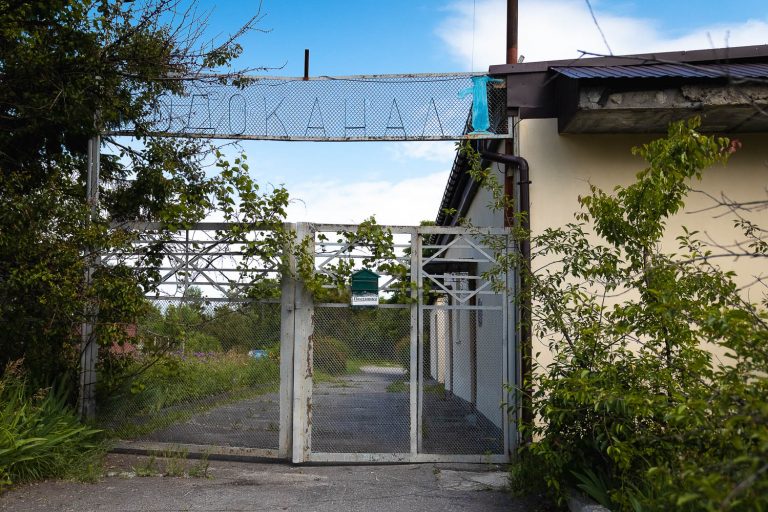
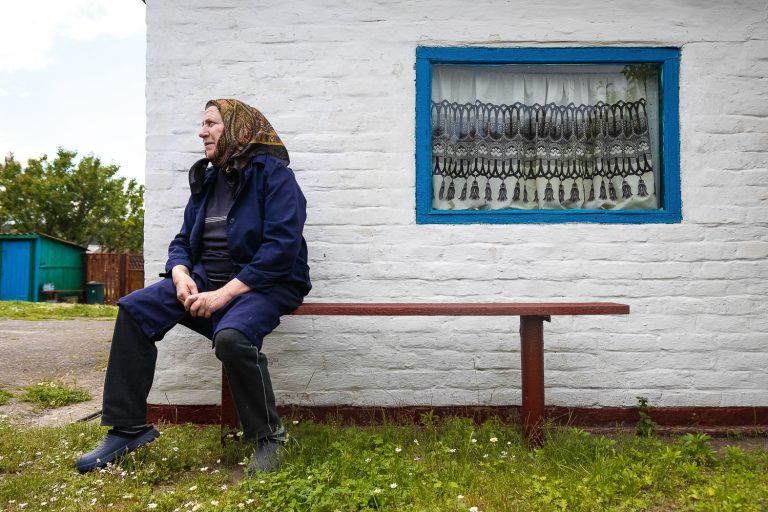
slideshow
During the expedition, the team collaborates with activist groups in rural communities. Together with local residents, they developed a plan to determine which water bodies are important to check first:
“It can be something at the level of intuition, somewhere it is specifically a point in an area where there is a suspicion that there may be a source of pollution nearby.”
After creating the plan, the group arrives, takes samples, and performs rapid tests on the basic physical and chemical parameters of the water (pH (hydrogen index), ammonium, nitrites, nitrates, phosphates, iron, copper, the oxygen content of open water, etc.) to find out what the potential problem is. Such fast methods can show controversial results, so an additional sample is taken to a specialized laboratory, where more advanced analysis is performed.
“Analysis and screening go first. This is a repeated analysis. It is important to do this systematically in order to determine a trend and use it as a starting point.”
While in Kaniv, the expedition team met with a local resident, environmental activist Halyna Karetnikova. Together, they took a water sample from the Dunaiets river to analyze.
“Residents of Kaniv are very interested in Dunaiets. This is because it originates somewhere from the village of Yabluniv, maybe even further, but most of what flows there is spring water. And there are many wells upstream.”
At the confluence of the Dunaiets and the Dnieper, the Ecoaction team took a water sample and immediately tested the temperature and its dissolved oxygen content. If this is not so relevant for wells or boreholes, then for open reservoirs it is quite an important parameter. The content of dissolved oxygen shows how sustainable an aquatic ecosystem is, how quickly it can recover and “digest” the pollutants that are present in it.

“So that people know what kind of water they drink”
In one day the group analyzed thirteen places in Kaniv, including the villages of Pekari and Stepantsy, which are part of the Kaniv amalgamated territorial community. Based on the research results, the organization’s participants concluded that the tested reservoirs had too large an amount of phosphates and ammonium.
“Ammonium is a precursor to nitrates, one of the nitrogen compounds that can be transformed into each other in groundwater. In fact, ammonium can go into a nitrate state, which is more toxic. That is, if here — in both wells in Pekari village — there are high values for ammonium, then it is important to continue monitoring. If they switch to a new quality and become more toxic, the danger to the health of people who drink its water will increase.”
The excess of phosphates and iron in Kaniv has not been recorded: there is a borderline state, but in the villages of the Stepanets community there are many more prerequisites for the spread of these substances and eutrophication:
Eutrophication
Saturation of water bodies with biogenic elements, which causes the reproduction of algae, a decrease in water transparency and dissolved oxygen content, as well as the death of bottom organisms.“In the Rosava River and nearby, there was a leak from the treatment facility of one of the factories, so there was also a high level of phosphates and, in one case, nitrites. They can grow in the water and this leads to overgrowth of the reservoir. And at some point, if this process deepens, it can even lead to waterlogging.”

In Ukraine, there are three standards for drinking water, which depend on the source: packaged water, from the water supply system, and from the well. Expedition participants can compare the measurements with the standards for bottled water, because it has the highest standards, which often meet European standards for drinking water. However, the standards are different for rural communities:
“The human body is the same in both the village and the city. Why are standards different? There is such an explanation that it is known (or suspected) how deplorable the water quality is at the ground water level, at the level of wells. Therefore, the maximum permissible concentrations and very, very weak norms are artificially inflated. That is, there may be a high value that is harmful to the body, but, according to the law, this will not be an excess.”
All results are placed on the expedition’s online map. The Ecoaction team continues to keep in touch with local activists who are interested in monitoring the condition of their wells or other sources of drinking water.
“Once a season, twice a season, we need to make such measurements in order to track the trend at these and other points that we are interested in. Because, in fact, people had a request to go to another neighboring community, but it would simply be unrealistic to work it out in one day.”
Ecoaction plans to use the information collected during the expedition for advocacy activities to achieve changes in environmental legislation.

Ecoaction receives Ukrainian grants for the implementation of its projects, as well as support from international organizations. When these funds are not enough, the Community Organization initiates fundraising. Thus, with the help of benefactors, the organization purchases test systems for rapid analysis during an expedition so that local residents can independently continue monitoring.
“I hope that this will become an example not only for those people we came to visit, but also for their neighbours. And so, the practice of, if not state monitoring, then at least public monitoring, will spread because this is important socially significant information about water quality. And it is important that people know what kind of water they drink, and the water quality where they live.”
supported by
This material was created with the support of the Swiss embassy in Ukraine. Ukrainer is solely responsible for the content. The opinion of the material creators does not necessarily reflect the views of the donor.
